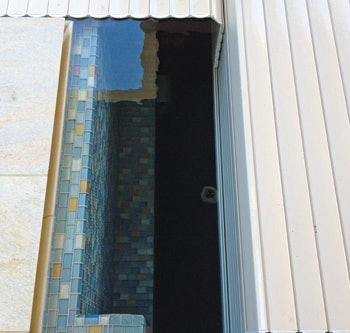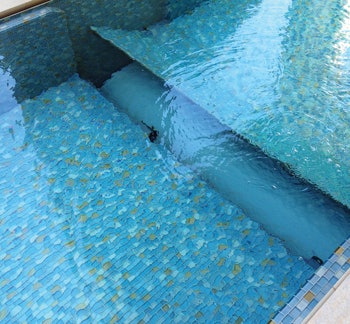
Custom swimming pools come in an endless variety of shapes and sizes designed to harmonize with discerning homeowners’ often highly stylized homes and landscapes. That variety of design presents a significant challenge for manufacturers supplying automatic safety covers for the ever-expanding variety of pool shapes and associated features. The following looks at how covers made with PVC slats offer an attractive way to overcome that limitation.
Automatic pool covers provide homeowners with a host of important benefits. Be it energy efficiency, reduced maintenance, improved water quality and safety, automatic covers enhance the experience of pool ownership with the touch of a button – a set of benefits that has driven steady growth in the automatic cover market.
The primary drawback to automatic covers, however, is that by their very nature they are, for the most part, limited to rectangular pools. Even the slightest offset or violation of the rectangular water surface can mean that most covers won’t fit. Overcoming that limitation has posed a real challenge for cover manufacturers and builders alike.
One method of covering non-rectangular pools is to surface-mount tracks on the pool deck outside the pool’s perimeter. Functionally speaking the approach works well enough, with the glaring exception that the tracks tend to mar the appearance of the deck. For clients investing in attractive design and materials, that option is a non-starter.
Another approach is to use a “cantilevered deck.” In this scheme, builders construct a rectangular shelf, inside of which they create any pool shape the client wants. The cover tracks are then concealed beneath cantilevered deck sections that follow the inside contours of the pool. That approach works beautifully, but is extraordinarily expensive. It also leaves a wide slot in the pool walls just above the waterline and eliminates the possibility of using various edge treatment details.
USING SLATS
Since the late ’90s, Aquamatic (Gilroy, Calif.) has offered a third option through its Hydralux product line. This system uses a cover made of interlocking PVC slats housed in a vault, typically in the pool’s bottom, or in some cases on one end of the pool at deck level. The slats are manufactured to different lengths and contours so that when they are deployed, they can cover pools of almost any shape — and they require no tracks or lead bars.
The single limitation: from the point where the vault is located, the slats have to spread out from the pool’s widest point to its most narrow. (That constraint can be overcome by using multiple covers that converge.)
The popularity of slat covers has increased in recent years for a number of reasons including energy efficiency concerns, as ease of maintenance and water quality — as has been the case with more standard rectangular covers. The ability to cover pools other than perfect rectangles with no visual compromise, however, has proved useful to designers and builders focusing on the high-end custom market. And as many builders have reported in recent years, the custom market has proved the most recession-proof of all industry segments.
“The high-end custom market has enabled us to weather the storm of recent recession,” says Bruce Dunn of Mission Pools, a well-established builder in Escondido, Calif. “These are clients who are able to fund their projects, unlike many middle class homeowners who continue to struggle to secure financing. These days we’re doing fewer projects with much larger price tags.”
Such projects cover a gamut of shapes and styles and even rectilinear pools, such as those pictured in these pages, which include elements that violate a perfectly rectangular shape and are therefore not suitable for standard automatic covers.
That was exactly the situation for a project recently completed for an energy-conscious client in La Jolla, Calif. The project was a collaboration between builder Mission Pools, designer Skip Phillips of Questar Pools (Escondido) and engineer David Peterson of Watershape Consulting (Solana Beach, Calif.).


UPSCALE VALUE
The pool was part of a complete teardown and reconstruction of the home, which features a beautiful contemporary design and a host of expensive details. The all-glass tile pool is essentially a rectangle built primarily for lap swimming. Among a host of other features, it includes a radiant heating system in the walls, and the clients are reportedly very concerned with energy conservation.
Although rectilinear in design, the vessel includes an offset step area that is wider than the rest of the pool, making the use of a standard cover nearly impossible. The solution was to turn to the Hydralux system.
“It’s a beautiful project,” says Phillips. “The clients wanted a cover, but it had to work with the shape of the pool and not disrupt the design. Not only does this type of cover enable you to cover pools that aren’t pure rectangles, the product has a great look that appeals to many discerning clients.”
Although such a cover is considerably more expensive than a standard cover, Phillips reports that in his practice, which focuses exclusively on the high-end custom market, he offers it as one of several menu items. “It’s similar to the way we talk about having an all-glass tile surface,” he says. “We discuss the advantages and the value engineering and leave it to the clients to decide if it’s worth it. In this case, it made perfect sense and they decided to go with the concept.”
According to Tom Dankel, vice president of Aquamatic, “This was one of those situations where doing something like mounting tracks on the decks was completely out of the question because of the design, which included a beautiful edge detail and a vanishing edge to reduce waves for lap swimming. This type of cover provides a viable solution for that kind of setting.”
PRECISION CONSTRUCTION
One of the requirements for using slat covers, and a caveat that applies to the entire high-end custom market, is that pools at this level require both competent design and construction.
Because each slat cover is different, they all are in essence custom built in the factory. That requires clear and timely communication between the pool designer, builder and manufacturer so the cover can be built to fit the pool exactly and successfully operate in the specified environment. It also means builders must build the pools and the vaults containing the covers to precise tolerances.
According to Dunn, “Working in the custom market doesn’t mean that you wake up one day and all of a sudden say that you’re a custom builder. We’ve been building these types of pools for years and understand the demand for precision and how to execute complex details. You have to have the experience and skill required to be adaptable.”
In the case of the La Jolla project, according to Dankel, “We had precise drawings of the pool, which made it easy to establish the exact dimensions of the cover and,” he adds, “the folks at Mission Pools and their crews did an outstanding job of constructing the pool, so we had a perfect canvas.”
In addition, the Hydralux system requires an adjacent, in-line vault outside of the pool structure that houses the hydraulically operated system that drives the reels that release and retract the cover. This system, explains Phillips, “requires a great deal of torque to retract the cover because the system has to overcome the buoyancy of the cover. The larger the cover and the deeper the vault, the more power it takes to operate. That can mean making adjustments to the design and where you place the vault.”
As Dankel points out, there are situations where these covers, for a variety of reasons, are not located on the pool floor, but on the ends of pools as well. “We’ve even had one installation where the cover was located in the ceiling over an indoor pool,” he reports.
The vault lid is another detail that is well-suited to the custom market. Made of stainless steel and also operated hydraulically, the lids are made to accept the interior surface material, be it plaster, pebble finishes or tile.
“It looks great in all tile installation,” explains Phillips, “because the patterning of the tile gives you an opportunity to visually conceal the lid. If you look closely you can see it because the slot surrounding the lid is wider than the grout joint, but for the casual observer it’s not a visual disruption.”
The slats in the Hydralux system are available in six different colors enabling a close, if not exact match with surrounding deck material. In the case of the La Jolla project, the beige color is an extremely close fit with the earth tones of the surrounding deck material.

THE COOL FACTOR
The look and “behavior” of the covers also carry an increased level of appeal and interest. “There’s definitely a ‘cool’ factor,” says Dunn. “It’s fun to watch them cover the pool and then retract. And when the pool is covered, there an appealing look to the design.”
Indeed, Dankel reports that even clients with perfectly rectangular pools on rare occasions will opt for the cover based entirely on appearance. “We supplied a cover on an indoor pool that was a perfect rectangle,” he recalls. “But because the pool area was surrounded by interior windows, it was visible from most of the house and the clients didn’t want to look at a standard vinyl cover. They wanted a cover to reduce evaporation, which is always helpful in indoor pools, but in this case, they made the additional investment based on the looks of the cover.”
Because these covers are significantly more expensive than more typical, purely rectangular products, they are clearly not for every client or every situation.
Says Phillips, “I personally love rectangles for reasons other than their ability to accept a standard cover. It’s a shape that can be designed to look great across a spectrum of styles and often it’s the best choice. So I really don’t see these slat covers replacing more standardized covers, but they do provide a good solution in the right setting with the right clients.”
Comments or thoughts on this article? Please e-mail [email protected].
NOT A SAFETY COVER
For all of the advantages, slat covers are not considered safety covers because they do not meet ASTM standards for covers designed to prevent drowning. This is because slat covers are not secured on the edges by tracks and water will migrate between the tracks if someone stands on the cover.
In the La Jolla project, the pool was built with a small ledge just below the waters surface so the cover is supported on the edges. “No it’s not a safety cover,” says Dankel, “but with the ledge, you can stand on it.”
“I believe that these covers do provide a measure of safety,” says Phillips. “but we are careful to make sure that the clients understand in no uncertain terms, it’s not, technically speaking, a safety cover.”








































